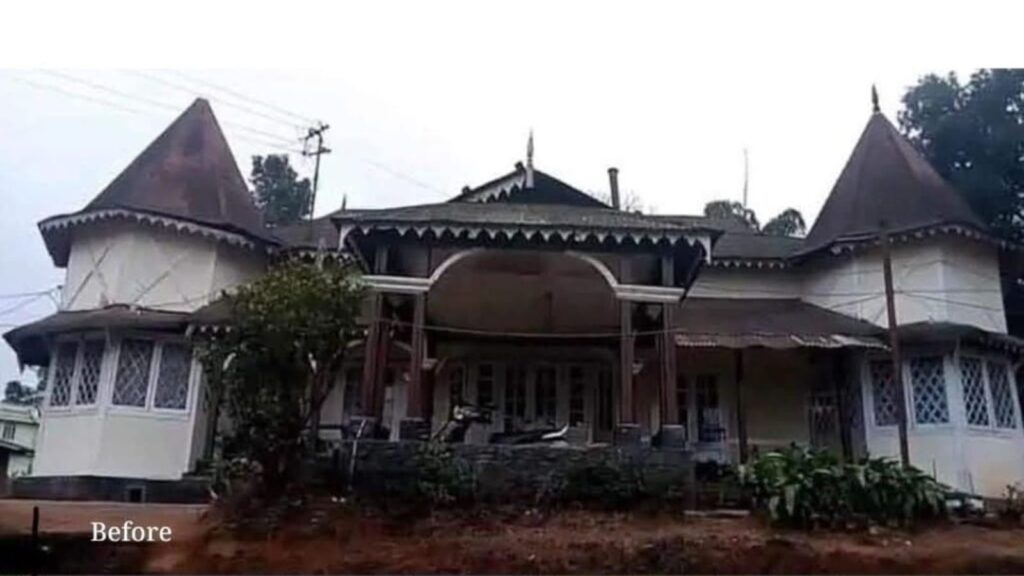On September 21, 1949, a striking colonial-style bungalow in Shillong became the site of a defining moment in Manipur’s history: the then ruler of the erstwhile princely state, Maharaja Bodhchandra Singh, signed the Manipur Merger Agreement with the then Union government. The circumstances surrounding the signing have long cast a shadow over Manipur’s relationship with the Union.
Last week, the bungalow, known as the Redlands Building or the Manipur Rajbari, was demolished. While the government has claimed the move was for “restoration” due to “instability and weakness of structural elements”, the demolition has sparked outrage and grief in Manipur.
The Redlands Building, with its distinctive late-colonial structure and steep sloping roofs, stood in Shillong’s prime Laitumkhrah area and had served as Bodhchandra’s residence. When news of its demolition reached Imphal, where it is regarded as a vital piece of the state’s political and cultural heritage, it triggered widespread shock.
Meghalaya Chief Minister Conrad Sangma, who happened to be on a two-day visit to Manipur, was questioned about the move. He told reporters that the order had not come from his government but had been executed by the government of Manipur, to which the estate was transferred in 2021.
Facing mounting criticism, the General Administration Department (GAD) of Manipur on Monday issued a statement saying the demolition was part of the “reconstruction/restoration” component of an “infrastructure development” project within the complex. Its Detailed Project Report (DPR), approved by the North Eastern Council (NEC) in 2023, was awarded to Meitei Construction Ltd the same year, it said.
 While the government has claimed the move was for “restoration” due to “instability and weakness of structural elements”, the demolition has sparked outrage and grief in Manipur. (Photo: K Meghachandra)
While the government has claimed the move was for “restoration” due to “instability and weakness of structural elements”, the demolition has sparked outrage and grief in Manipur. (Photo: K Meghachandra)
“As a first step, the dismantling of a dilapidated part of the building was taken up. However, there was an apprehension that the remaining part of the building may collapse due to instability and weakness of the structural elements. Hence, the dismantling of the whole structure was necessitated and done manually with due care,” the GAD statement stated.
It added that the dismantled components — including wooden doors, windows, and wall plates — have been stored, and that a replica of the Redlands Building would be reconstructed using recovered material. A five-member “Monitoring and Supervision Committee” has also been constituted to oversee all aspects of the reconstruction and restoration process.
However, the explanation has done little to quell anger. While students of Imphal’s Dhanamanjuri University protested on Tuesday at the Planning and Development Authority office, Manipuri residents of Shillong have announced a protest on Wednesday.
The demolition — carried out while Manipur remains under President’s Rule, which was imposed in February — has also drawn criticism from across the political spectrum.
Calling the incident “painful”, former Manipur CM N Biren Singh said, “It takes time to build something good but it can be destroyed very quickly… Sadly, the historic Rajbari was completely destroyed, saying the repair work could not be carried out. This is truly painful because it was part of our shared history and identity. It is absolutely necessary that it is rebuilt to its original state so that future generations know what once stood there. I am told that the Governor Ajay Bhalla-led administration has formed a committee to look into the matter. I only hope that it leads to truth and restoration.”
BJP Rajya Sabha MP Leishemba Sanajaoba, the grandson of Bodhchandra, called the demolition “illegal”.
Days before the demolition, BJP leader and former Union Minister of State for External Affairs and Education R K Ranjan Singh had written to Bhalla, appealing against the proposed move. In his letter, Ranjan cited the building’s “historical, archival and architectural value”, describing the Manipur Merger Agreement “a foundational moment in the political and foundational history of Manipur”.
“The building is not merely a physical structure; it stands as a symbol of the sovereignty transition and the collective memory of the people of Manipur, marking a significant event in the post-Independence integration process of princely states into the Indian Union. Its demolition would mean the irretrievable loss of an invaluable heritage site irrevocably tied to the history of our state,” he wrote.
The Congress, on the other hand, has sought to pin responsibility of the demolition on the previous BJP government led by Singh. “This work order was issued in 2023. Hence, the then BJP is responsible for it. Responsibility should be fixed and they should be booked by the Bhalla administration,” Manipur Congress chief K Meghachandra said.
The signing of the agreement itself remains a deeply contested issue. Bodhchandra was under house arrest at the Rajbari when he signed the document, something that continues to fuel debate over the legitimacy of the merger.
Political scientist Sanjib Baruah, in his book In the Name of the Nation: India and its Northeast, described the merger as one achieved “with a combination of cajolement, promises that were not kept, and plain trickery”. Among many sections of Meitei society, the merger remains an open wound, seen as the starting point of decades of alienation and insurgency in the state.

